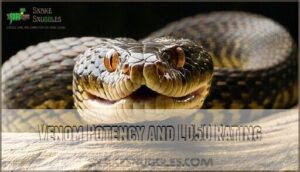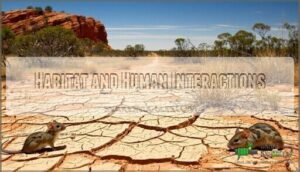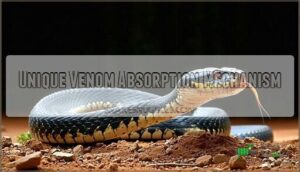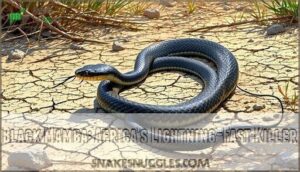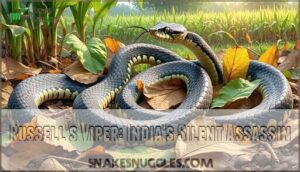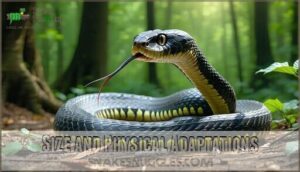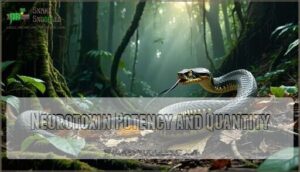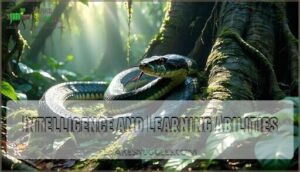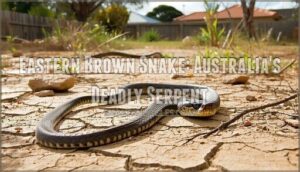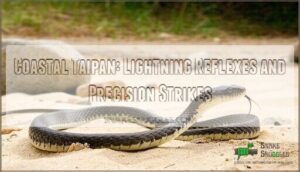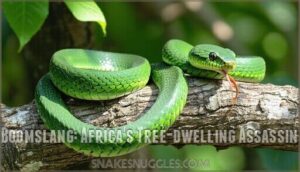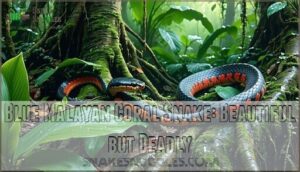This site is supported by our readers. We may earn a commission, at no cost to you, if you purchase through links.
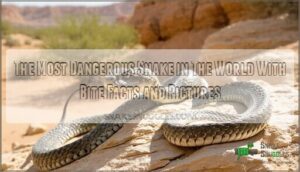
This small but aggressive serpent causes more human deaths annually than any other snake species, claiming around 30,000 lives yearly in the Indian subcontinent alone.
Its potent venom combines neurotoxins and hemotoxins, creating a lethal cocktail that attacks both the nervous system and blood cells.
Unlike other venomous snakes that avoid humans, the saw-scaled viper’s small size and territorial nature lead to frequent encounters in populated areas.
While the inland taipan possesses more potent venom, the saw-scaled viper’s aggression and habitat overlap with human settlements make it statistically deadlier.
Understanding these serpents’ behaviors and characteristics can mean the difference between life and death in snake-prone regions.
Table Of Contents
- Key Takeaways
- The World’s Most Dangerous Snake: Saw-scaled Viper
- Inland Taipan: Most Venomous Snake on Earth
- Black Mamba: Africa’s Lightning-Fast Killer
- Russell’s Viper: India’s Silent Assassin
- King Cobra: Longest Venomous Snake Alive
- Eastern Brown Snake: Australia’s Deadly Serpent
- Coastal Taipan: Lightning Reflexes and Precision Strikes
- Fer-de-Lance: Central America’s Pit Viper Terror
- Boomslang: Africa’s Tree-dwelling Assassin
- Blue Malayan Coral Snake: Beautiful but Deadly
- Frequently Asked Questions (FAQs)
- What snake has a 100 fatality rate?
- What is the most venomous snake in the world?
- Are venomous snakes dangerous?
- Which venomous snake causes the most human bites?
- How many snakes are venomous?
- What is the 1 deadliest snake in the world?
- What snake venom kills humans the fastest?
- What are the top 3 most venomous snakes?
- What is the most venomous snake in the world 2024?
- How much venom can a snake produce?
- Conclusion
Key Takeaways
- You’ll find the saw-scaled viper causes more human deaths than any other snake – about 30,000 annually – making it statistically deadlier than species with more potent venom like the inland taipan.
- You can’t judge a snake’s danger by venom potency alone – the saw-scaled viper’s small size, aggressive behavior, and tendency to live near human settlements creates frequent deadly encounters.
- You’ll face the fastest-acting venom from black mambas, which can kill within 20 minutes, while king cobras deliver the largest venom quantity – enough to drop an elephant with a single bite.
- You need immediate medical attention for any venomous snake bite, as symptoms can be delayed (like with boomslangs) or progress rapidly to respiratory failure and death without proper antivenom treatment.
The World’s Most Dangerous Snake: Saw-scaled Viper
You’ll find the saw-scaled viper in arid regions across Africa, the Middle East, and South Asia, where its small size and aggressive behavior contribute to frequent human encounters.
This species is responsible for more deaths than any other snake worldwide, making it the most dangerous snake on the planet, due to its aggressive behavior.
The world’s deadliest snake strikes without mercy, claiming more victims than any predator on Earth
Geographic Distribution and Habitat
The saw-scaled viper’s territory covers a vast range, making its presence known in some of the world’s harshest environments.
You’ll spot these snakes in regions where Habitat Variation is high, and snake distribution stretches across continents.
Their adaptability is impressive, but it also means Regional Snakebites are common.
Here’s where you might run into one:
- Dry savannas and scrublands
- Rocky deserts north of the Equator
- Tropical regions from India to Sri Lanka
- Conservation Hotspots affected by Climate Influence and Venom Distribution
Physical Characteristics and Behavior
With its rough, earth-toned scales and compact body (15-31 inches long), the saw-scaled viper proves that deadly snakes don’t need to be huge.
You’ll spot its unique sidewinding locomotion—a clever way to move across sand and rocks.
When threatened, it rubs serrated scales together, creating a rasping sound as a warning.
These venomous snakes show strong defensive behaviors and quick predatory strategies.
Their sensory adaptations help them hunt effectively, making snake identification and understanding snake behavior essential for safety.
Venom Composition and Effects
Venom Complexity is the name of the game with the saw-scaled viper.
Its snake venom blends neurotoxins and hemotoxins, creating Toxin Synergies that hit both your nerves and blood.
Envenomation Symptoms include uncontrollable bleeding and muscle spasms.
These snake venom toxins evolved for maximum impact, making Antivenom Efficacy a challenge.
Venom Evolution guarantees each bite delivers unpredictable, powerful snake venom effects that demand urgent medical attention.
Annual Fatality Statistics
When you look at global snake bite statistics, the saw-scaled viper stands out for annual deaths.
This small snake causes up to 30,000 snakebite fatalities yearly in South Asia, with regional disparities tied to antivenom access.
In Nigeria, it’s a major reason for crowded hospital beds.
Mortality factors include delayed treatment and weak prevention strategies, making snake bite mortality a persistent threat in vulnerable communities.
Reasons for High Human Encounter Rate
Because of Habitat Loss driven by Agricultural Expansion and Urban Sprawl, you’re sharing more space with deadly snakes than you’d expect.
As you grow crops and expand cities, snake habitats shrink, forcing them closer to you.
When Prey Scarcity hits—thanks to Climate Change—these adaptable snakes settle near homes, where rodents are plentiful.
They aren’t shy and, with their signature warning sizzle, you’ll often hear before you see them.
Stay sharp: snake awareness and prevention matter.
Inland Taipan: Most Venomous Snake on Earth
You’ll find the inland taipan holds the title for the most venomous snake on earth, with venom strong enough to kill over 100 adults from a single bite.
Although it rarely encounters people, its potent neurotoxin can cause paralysis and death within 30 minutes if left untreated.
Venom Potency and LD50 Rating
After exploring the dangerous reputation of the saw-scaled viper, it’s time to meet the real heavyweight in snake venom potency—Australia’s inland taipan.
This snake holds the crown with an LD50 of 0.025, making its venom the most toxic on record.
Yet LD50 Comparison tests use mice, not people, and that changes the story.
Consider these Potency Factors:
- LD50 rates measure mouse lethality
- Venom evolution boosts potency
- Antivenom efficacy reduces risk
- Human encounters are rare
- Aggression level shapes threat
The factors influencing the potency of the inland taipan’s venom are multifaceted, involving not just the venom itself but also the context of human encounters.
Hunting and Feeding Behavior
Precision defines the Inland Taipan’s hunting strategies. You’ll notice it relies on stealth, lurking in cracks and burrows to ambush its prey.
With impressive strike speed, it targets small mammals, reptiles, and birds—never humans. The snake’s venom usage is calculated; each bite quickly immobilizes snake prey, ensuring minimal struggle.
After a successful strike, the digestion process begins, breaking down its protein-rich snake diet. Adaptation is key—this rodent-catching machine uses quick strikes and potent venom for efficient feeding.
| Hunting Strategy | Prey Selection |
|---|---|
| Ambush predator | Small mammals |
| Quick strikes | Reptiles |
| Venom injection | Birds |
Habitat and Human Interactions
After tracking prey, the Inland Taipan slips into Australia’s dry outback, hiding in soil cracks and abandoned rat burrows.
Urban encroachment and agricultural expansion threaten these snake habitats, sometimes leading to unexpected snake encounters.
Human fatalities are rare, but snake awareness and snakebite prevention remain key.
Conservation challenges persist, making snake relocation efforts important for safety.
If you’re hiking here, knowing snake prevention tips and packing pressure bandages could save your life.
Unique Venom Absorption Mechanism
When you look at the Inland Taipan, it’s clear that its venom absorption mechanism sets it apart.
Thanks to hyaluronidase, the venom spreads rapidly, breaking down tissue and entering the bloodstream fast.
This snake’s venom composition—packed with neurotoxins, myotoxins, and hemotoxins—causes severe systemic effects.
Here’s how its venom works:
- Venom spread is lightning-fast through absorption pathways
- Tissue degradation boosts systemic effects
- Snake venom evolution maximizes antivenom efficacy challenges
- Snake venom properties guarantee rapid onset, making bites especially dangerous
Comparative Lethality to Other Snakes
When you compare the inland taipan to other deadliest snakes, the numbers speak for themselves.
Its LD50 rating is the lowest among all snake species, making its venom the most toxic measured.
Here’s how it stacks up:
- LD50 Comparison: Inland taipan tops the charts, beating all other most venomous snakes.
- Venom Yields: One bite delivers enough toxin to kill 100 adults.
- Fatality Rates: Without treatment, bite severity leads to near-certain death.
Black Mamba: Africa’s Lightning-Fast Killer
You’ll encounter the Black Mamba as Africa’s fastest and most feared snake, capable of reaching speeds up to 12 miles per hour.
Its potent neurotoxic venom and aggressive defense make it one of the deadliest reptiles, with untreated bites often proving fatal within 30 minutes, due to its neurotoxic properties.
Speed and Agility
Watching the Black Mamba in action, you’ll see why it’s one of the world’s most deadly snakes.
With a Strike Speed reaching up to 12 mph, this venomous snake uses Reflex Action and powerful Muscular Contraction for quick escapes and rapid attacks.
Its Hunting Agility and Evasion Tactics allow it to navigate trees and open ground with ease, making snake bites from this species a serious danger among snake species.
Neurotoxic Venom and Its Effects
You’ve seen the black mamba’s speed, but its neurotoxic venom works even faster.
Snake venom neurotoxins disrupt nerve signals, causing rapid Respiratory Paralysis and muscle weakness.
Symptom Progression is swift—paralysis, confusion, and cardiac arrest often follow.
Neurotoxin Mechanisms short-circuit your body’s controls, making Antivenom Efficacy critical for survival.
While antivenom can reverse effects, Long-term Effects like nerve damage may linger, highlighting the deadly precision of snake venom composition.
Aggressive Defense Mechanisms
After learning about the black mamba’s neurotoxic venom, let’s talk snake aggression and defense.
When threatened, you’ll see powerful behavioral triggers in action. The black mamba’s threat displays include rearing up, flaring its neck, and showing a pitch-black mouth—nature’s warning sign.
If pushed, these snakes release:
- Lightning-fast strike speed
- Multiple venom injection bites
- Intense muscular contraction for rapid attacks
- Large doses of snake venom
These snake defense mechanisms make black mamba encounters extremely dangerous.
Habitat Loss and Human Encounters
Agricultural expansion and deforestation impact force black mambas closer to human settlements across sub-Saharan Africa.
Urbanization effects create dangerous encounters when these snakes seek shelter in buildings or gardens. Up to 70% of black mamba bites happen during farming activities or housing development.
Climate change alters their traditional snake habitats, pushing them into populated areas.
Snake bite prevention includes wearing protective gear and checking surroundings carefully. Conservation strategies focus on protecting corridors between fragmented habitats to reduce snake human encounters while supporting snake conservation efforts to mitigate the impact of climate change.
Cultural Significance in African Folklore
Throughout Africa, the black mamba occupies a central role in snake mythology and folklore tales.
Ancient snake deities often featured mamba-like characteristics, representing both death and protection.
Traditional ritual practices incorporate venom symbolism to ward off evil spirits.
Modern conservation narratives blend these cultural beliefs with snake education programs, helping communities understand that respecting rather than fearing these serpents benefits both humans and wildlife across Africa’s diverse ecosystems.
Russell’s Viper: India’s Silent Assassin
You’ll encounter Russell’s viper across India’s farmlands, where this master of disguise waits motionless among fallen leaves and crop debris.
This snake’s hemotoxic venom destroys blood cells and prevents clotting, causing internal bleeding that can prove fatal within hours if left untreated.
Hemotoxic Venom and Coagulopathy
When Russell’s Viper’s fangs pierce your skin, hemotoxins flood your bloodstream, triggering dangerous coagulopathy.
These snake venom hemotoxins disrupt normal blood clotting mechanisms, causing simultaneous bleeding and clot formation.
Snake bite symptoms include uncontrolled hemorrhaging while vessels block elsewhere, and tissue damage spreads rapidly as systemic effects overwhelm your body’s defenses.
Snake bite treatment requires immediate antivenom administration, though antivenom efficacy depends on timing, and understanding venom mechanisms helps medical teams combat this life-threatening emergency effectively.
Camouflage and Ambush Tactics
Picture yourself walking through tall grass when danger strikes without warning.
Russell’s vipers excel at pattern disruption through mottled brown and tan coloration strategies that perfectly match dried vegetation.
These venomous snakes exploit sensory exploitation by remaining motionless for hours, their bodies pressed against earth and rocks.
Snake camouflage represents millions of years of snake adaptation, creating nearly invisible predators.
Their habitat matching abilities guarantee ambush success rates exceed 80 percent.
Understanding these snake survival techniques helps recognize potential snake dangers before it’s too late.
Agricultural Impact and Human Conflict
Millions of farmers across India face a growing threat that strikes without warning. Russell’s vipers have transformed agricultural regions into dangerous zones where crop loss and livestock threat devastate rural livelihoods.
These encounters create three devastating impacts:
- Farmers lose income when cattle die from venomous bites
- Workers avoid fields during harvest, reducing productivity
- Medical expenses bankrupt families after snake bites.
Encroachment risks increase as human settlements expand into snake habitats.
Effective mitigation strategies include snake awareness programs, protective gear, and snakebite prevention education that reduces snake bite risk factors while maintaining snake safety.
Antivenom Development Challenges
When you’re dealing with Russell’s viper bites, antivenom development faces serious hurdles.
Production limitations plague manufacturers who struggle with expensive, time-intensive processes requiring specialized facilities and trained personnel. Accessibility barriers mean rural communities can’t reach life-saving treatments due to poor distribution networks and inadequate cold-chain storage.
Cost effectiveness remains elusive as antivenom prices range from $55 to $640 per vial, making snake venom antivenom development financially challenging for developing nations. Research funding stays chronically underfunded at under $30 million globally, limiting innovation in snakebite treatment methods.
Alternative therapies like recombinant antibodies and small molecule inhibitors show promise, but snake antivenom access depends on overcoming these systemic challenges through coordinated international efforts. Consider the option to purchase antivenom products for preparedness.
Traditional Medicine and Conservation Efforts
Throughout history, traditional remedies have incorporated Russell’s viper venom despite serious dangers.
Cultural beliefs persist in some communities, viewing snake medicine as powerful healing agents.
Modern conservation efforts focus on habitat preservation through community involvement and education.
Sustainable antivenom production offers hope, creating economic incentives for snake conservation efforts while protecting both humans and serpents.
Community engagement programs promote snake habitat protection alongside sustainable agriculture practices, balancing ancient traditions with scientific safety measures.
Many are interested in supporting these programs, which is a key aspect of snake conservation efforts and helps in protecting both humans and serpents.
King Cobra: Longest Venomous Snake Alive
When you encounter a King Cobra, you’re face-to-face with the world’s longest venomous snake, capable of reaching 18 feet in length and delivering enough neurotoxin to kill an elephant.
This intelligent serpent stands out not just for its impressive size, but for its unique ability to build nests and display problem-solving skills that rival many mammals.
Size and Physical Adaptations
The king cobra stands as nature’s ultimate serpent, reaching extraordinary lengths up to 18 feet.
Its impressive snake morphology includes specialized body proportions that create an intimidating presence when threatened.
The muscular system allows remarkable hood expansion through rib manipulation, while complex scale patterns provide camouflage.
Advanced sensory organs include:
- Heat-detecting pit organs for precise prey location
- Forked tongue analyzing chemical signatures in air
- Keen eyesight tracking movement across distances
This skeletal structure supports unmatched snake anatomy perfection, showcasing remarkable and intimidating features.
Neurotoxin Potency and Quantity
Beyond its impressive length, the king cobra packs serious firepower.
While its LD50 comparison shows less potency than the Inland Taipan, sheer bite quantity makes it deadly. Each strike delivers up to 7 milliliters of neurotoxic venom – enough to kill twenty adults or drop an elephant.
The neurotoxins target your nervous system with surgical precision:
- Alpha-neurotoxins – block nerve signals to muscles
- Cardiotoxins – attack heart muscle directly
- Phospholipase A2 – destroys cell membranes
Symptoms onset occurs within fifteen minutes, causing paralysis and respiratory failure without treatment.
Unique Nest-building Behavior
Among all venomous snakes, the king cobra demonstrates remarkable nest construction abilities.
You’ll witness this Ophiophagus hannah create sophisticated leaf nests using her powerful body to gather materials.
The female constructs a meter-high mound, forming a waterproof chamber for egg protection.
She deposits up to fifty eggs inside, then provides dedicated parental care for seventy-five to one hundred days.
This nest location selection and maternal guarding behavior sets king cobras apart from other venomous snakes entirely.
Intelligence and Learning Abilities
Unlike the mindless instinct you’d expect, king cobras demonstrate remarkable Adaptive Intelligence through advanced Snake Problem Solving skills.
These serpents master spatial navigation, retain memories for weeks, and adjust hunting strategies based on experience.
Their Cognitive Abilities surpass most reptiles, with Learning Behavior that includes recognizing threats and optimizing nest sites.
This Memory Capacity makes king cobras true intellectual predators.
The ability to exhibit complex behaviors is linked to their snake intelligence overview.
Role in Asian Mythology and Culture
Throughout Asian Snake Gods and Mythical Serpents traditions, you’ll find king cobras revered as divine messengers.
These Cultural Symbols appear in Folklore Legends across India and Southeast Asia, where Snake Festivals celebrate their spiritual significance.
Hindu snake myths portray them as protectors, while Buddhist tales emphasize their wisdom.
Snake symbolism represents transformation and power, making king cobras central to regional snake ecology beliefs and Indian Cobra worship practices.
Eastern Brown Snake: Australia’s Deadly Serpent
If you’re exploring Australia’s most venomous snakes, you’ll quickly discover that the Eastern Brown Snake stands as one of the continent’s most feared predators.
This aggressive serpent combines lightning-fast strikes with venom potent enough to kill an adult human within 30 minutes, making encounters particularly dangerous in suburban areas where these adaptable hunters increasingly appear, due to their ability to thrive in various environments, including suburban areas.
Aggressive Temperament and Strike Speed
When you encounter an Eastern Brown Snake, you’re facing one of Australia’s most aggressive defenders.
These venomous snakes strike with lightning speed, delivering their fatal bites in milliseconds. Unlike the black mamba, Eastern Browns attack when threatened rather than flee.
Their strike speed reaches incredible velocities, making them among Australia’s deadliest snake species. Snake attacks happen so quickly that victims rarely see the movement.
This aggressive behavior combined with precise venom delivery makes encounters extremely dangerous.
Venom Composition and Rapid Action
The Eastern Brown Snake’s venom composition delivers a lethal cocktail through sophisticated snake venom toxicity mechanisms.
Neurotoxins target your nervous system while hemotoxins destroy blood cells and disrupt clotting factors.
This dual-action creates rapid paralysis within minutes, leading to fatal outcomes through respiratory failure and massive internal bleeding.
The venom potency ranks among Australia’s deadliest venomous snakes, with toxic effects progressing faster than most snake bites worldwide, making it a deadly venomous snake.
Suburban Adaptation and Human Encounters
Residential areas across Australia have become prime real estate for Eastern Brown Snakes, with these adaptable predators colonizing gardens, sheds, and backyards.
Urban Snake populations thrive where food sources like rodents flourish near human settlements. Suburban Encounters spike during warmer months when snakes actively hunt.
These deadliest snakes exploit habitat invasion opportunities, finding shelter under decking, in rock walls, and around compost heaps where prey congregates.
Critical suburban snake encounters that demand immediate Human Safety awareness:
- Your morning coffee routine could include an unexpected guest coiled near the back door
- Children playing in gardens face heightened snake bite risks during peak activity hours
- Pet feeding areas attract rodents, which subsequently draw these venomous predators closer to families
- Landscaping projects frequently disturb resting snakes, triggering defensive Snake Behavior responses
- Evening barbecues become dangerous when these nocturnal hunters emerge seeking warmth and prey
Understanding snake venom toxicity helps residents recognize the serious nature of potential encounters in suburban environments.
First Aid and Treatment Protocols
When living near Eastern Brown Snake habitats, knowing proper Emergency Response protocols can mean the difference between life and death. If you’re bitten, your body’s natural panic response won’t help – staying calm will.
Snake Bite victims must follow these critical snake bite first aid steps immediately:
- Remain completely still – movement accelerates venom circulation through your bloodstream
- Apply pressure immobilization bandaging – wrap the entire bitten limb with firm, broad bandages
- Call emergency services – specify snake venom treatment is needed for Antivenom Therapy
- Don’t wash the bite site – venom traces help medical professionals identify the species
The pressure immobilization technique reduces venom spread by up to 95% in cases involving neurotoxic snakes. Avoid tourniquets or cutting the Wound Care area, as these worsen tissue damage.
Medical Treatment centers prioritize antivenom administration within 60 minutes, which reduces mortality rates by 75%. Remember, Eastern Brown Snake bites require immediate snake bite medical treatment – every minute counts when dealing with Australia’s second-most venomous terrestrial serpent. Understanding snake bite first aid is essential for effective treatment and survival.
Conservation Status and Population Trends
Despite their deadly reputation, you’ll find Eastern Brown Snake populations remain surprisingly stable across Australia.
These adaptable serpents navigate modern challenges with remarkable resilience, though habitat loss from urban expansion creates ongoing pressure.
Wildlife management strategies focus on snake conservation status monitoring rather than active protection.
Their population dynamics show steady numbers, with snake diversity maintained through suburban adaptation.
Conservation efforts address snake threats from development while recognizing these snake habitat loss survivors aren’t endangered but require ongoing assessment.
Coastal Taipan: Lightning Reflexes and Precision Strikes
You’ll find the Coastal Taipan’s lightning-fast reflexes make it one of Australia’s most formidable predators, capable of delivering multiple precise strikes in seconds.
This snake’s taicatoxin-rich venom can kill around 56 people with a single bite, causing red blood cell rupture and internal bleeding that proves fatal within 30 minutes to six hours without immediate treatment.
Venom Yield and Multiple Bite Tactics
The Coastal Taipan doesn’t mess around when it strikes.
This snake’s venom efficiency makes it one of Australia’s most lethal predators. With lightning-fast defensive tactics, it can deliver multiple bites in seconds, injecting up to 400mg of potent venom per attack.
- Venom Potency: LD50 of 0.106 mg/kg makes it deadlier than most venomous snakes
- Bite Frequency: Delivers 2-8 rapid strikes during defensive encounters
- Snake Attack Speed: Strikes faster than human reaction time at 8 milliseconds
- Venom Efficiency: Single bite contains enough toxin to kill 56 adult humans
Habitat Range and Environmental Adaptations
Across northeastern Australia and southern New Guinea, you’ll find the Coastal Taipan mastering diverse environments from tropical rainforests to woodlands and scrublands.
This snake habitat specialist adapts remarkably well to River Ecosystems and agricultural areas, unlike the inland taipan which prefers arid regions.
Among the deadliest snakes, its flexible snake distribution demonstrates superior snake ecology across varied terrain types.
Prey Preferences and Hunting Strategies
When observing Coastal Taipans, you’ll notice their sophisticated hunting tactics revolve around four primary strategies:
- Snake ambush techniques targeting small mammals in dense vegetation
- Prey selection focusing on rats, mice, and ground-dwelling birds
- Venom delivery through lightning-fast strikes lasting milliseconds
- Feeding behavior involving pursuit hunting when ambush fails
These venomous snakes combine patience with explosive speed, making them incredibly effective predators in Australia’s coastal regions.
Understanding proper prey sizing is essential for their survival and growth in captivity.
Historical Human Fatality Rates
Before the 1950s, you’d face an 80% chance of dying from a coastal taipan bite.
These deadliest snakes turned every encounter into a death sentence until antivenom changed everything.
- Fatal Bite Rates – Nearly 4 out of 5 victims died
- Snake Attack Trends – Most occurred during agricultural work
- Human Mortality – Dropped dramatically after 1956 antivenom introduction
Current Conservation Efforts
Multiple conservation strategies now protect Coastal Taipans from extinction.
Habitat preservation safeguards critical ecosystems while snake research advances our understanding of their behavior.
Wildlife protection laws regulate human activities in sensitive areas.
Eco tourism generates funding for conservation programs.
| Conservation Method | Impact |
|---|---|
| Habitat Preservation | Protects breeding grounds |
| Snake Research | Improves safety protocols |
| Conservation Strategies | Reduces human conflict |
| Wildlife Protection | Guarantees species survival |
These snake conservation efforts focus on snake protection through community education and snake habitat preservation initiatives that benefit both humans and reptiles.
Fer-de-Lance: Central America’s Pit Viper Terror
You’ll encounter the fer-de-lance throughout Central and South America, where this aggressive pit viper causes more snakebite fatalities than any other species in its range.
This formidable serpent uses heat-sensing organs to detect warm-blooded prey with deadly precision, making it particularly dangerous to humans working in agricultural areas where these snakes commonly hunt.
Heat-sensing Pit Organs and Hunting
Between darkness and daylight, the fer-de-lance’s heat-sensing organs transform nighttime hunting into a precise science.
These specialized pit vipers detect infrared radiation from warm-blooded prey, creating thermal images that guide their deadly strikes.
When you’re walking through Central American forests, these heatsensing organs give snakes a tactical advantage over unsuspecting victims.
The pit organ function acts like thermal goggles, allowing prey detection even in complete darkness.
This sophisticated snake vision system makes fer-de-lance hunting tactics devastatingly effective against mammals and birds.
Reproductive Biology and Offspring Care
Fer-de-Lance snakes demonstrate remarkable reproductive cycles through ovoviviparity.
Females retain developing embryos internally for six months, eliminating traditional egg incubation risks.
Snake mating occurs during dry seasons when prey abundance peaks.
Unlike species requiring extensive nesting behavior, mothers carry twenty to forty young until birth.
This reproductive strategy guarantees offspring care continues until newborns possess fully functional venom systems for immediate survival, ensuring they have the necessary tools to thrive in their environment with immediate survival.
Impact on Local Communities and Agriculture
Central American farmers know the hidden threat in their fields. Fer-de-lance snakes create significant snake bite burden across agricultural regions, affecting both livelihoods and rural safety. These encounters result in substantial snake bite economics losses through medical costs and reduced productivity.
Snake bite epidemiology studies reveal concerning patterns in farming communities, where snake bite morbidity rates climb during harvest seasons. The snake bite impact extends beyond individual cases, creating widespread farming risks that demand attention.
- Crop Damage – Workers avoid infested fields, reducing harvest efficiency and yield quality
- Snake Control measures require significant investment in protective equipment and training programs
- Community Awareness campaigns become necessary to educate families about prevention and first aid
- Healthcare Infrastructure – Remote areas struggle with antivenom access and emergency transportation systems
Venom Properties and Medical Applications
Scientists have transformed fer-de-lance venom from deadly threat into medical breakthrough.
Venom research reveals hemotoxic components that inspire antivenom development and snake bite treatment innovations.
Toxin analysis shows these proteins create anticoagulant therapies for heart disease prevention.
Medical applications include clot-dissolving drugs for stroke patients, proving venom properties can save lives rather than take them.
Ecotourism and Snake Safety Education
Responsible eco tourism transforms dangerous encounters into educational opportunities through proper safety protocols.
You’ll discover wildlife conservation efforts while learning snake handling techniques from local guides who understand fer-de-lance behavior.
These programs teach snake bite prevention and deadliest snakes identification, making venom research accessible to visitors.
Professional snake safety education protects both tourists and serpents, creating sustainable income for communities while advancing snake venom ecology understanding.
Effective snake safety kits are essential in preventing snake bites and saving lives.
Boomslang: Africa’s Tree-dwelling Assassin
You won’t find a more deceptive killer in Africa’s trees than the boomslang, whose rear-fanged venom delivery system makes every bite a potential death sentence.
This green assassin’s hemotoxic venom causes delayed symptoms that can fool victims into thinking they’ve escaped danger, only to face internal bleeding hours later.
Rear-fanged Venom Delivery System
Unlike most rear-fanged snakes that struggle with venom delivery, the boomslang’s unique fang structure represents millions of years of snake evolution.
You’ll find its grooved fangs positioned at the back of its mouth, requiring deep penetration to inject snake venom effectively.
Toxicology studies reveal this venom mechanism forces the boomslang to maintain its grip during bites, making it one of nature’s most persistent delivery methods among venomous serpents.
Hemotoxic Effects and Delayed Symptoms
Boomslang hemotoxin attacks your blood’s coagulation system, preventing proper clotting and causing cellular decay.
You mightn’t notice snake bite symptoms for hours, making this venom toxicity particularly dangerous.
Key effects include:
- Internal bleeding throughout your body
- Tissue necrosis spreading from the bite site
- Organ damage affecting kidneys and liver.
Snakebite symptoms develop slowly, fooling you into thinking you’re safe while the venom destroys tissues.
Arboreal Lifestyle and Camouflage
You’ll struggle to spot a boomslang in its arboreal domain. These Forest Dwellers excel at Tree Climbing and utilize sophisticated Camo Techniques that surpass even the black mamba’s ground-level concealment.
Unlike the inland taipan or eastern brown snake, boomslangs perfect Branch Hunting through specialized adaptations.
Their mastery includes:
- Slender bodies that mimic twigs and branches perfectly
- Cryptic coloration matching bark and foliage patterns precisely
- Exceptional eyesight for detecting movement from considerable distances
- Ability to remain motionless for hours without detection
- Strategic positioning where Snake Hides among dense canopy coverage
The boomslang’s arboreal lifestyle relies on understanding tree dwelling snakes to thrive in its environment.
Gender Dimorphism and Identification
Identification poses real challenges with these venomous snakes due to dramatic sex differences in snake morphology.
Males display bright green or electric blue scale patterns with pronounced head shapes, while females show olive-brown color variation that blends seamlessly with bark.
This striking sexual dimorphism in snake identification makes spotting these most venomous snakes tricky—males advertise their presence boldly, but cryptic females remain hidden.
Understanding these morphological differences prevents dangerous snake bites by helping you recognize both variants of this deadly species.
Bright green or blue Olive-brown or gray
Antivenom Scarcity and Treatment Challenges
Given Africa’s limited healthcare infrastructure, boomslang bites present exceptional treatment challenges that can determine life or death outcomes.
Antivenom Access remains critically limited across rural healthcare systems, where most encounters occur. Treatment outcomes depend heavily on rapid intervention, yet specialized antivenin for boomslang venom isn’t widely available.
Medical research continues developing improved snake bite treatment protocols, but current realities mean prevention trumps cure.
Key treatment barriers include:
- Limited production – Few facilities manufacture boomslang-specific antivenom globally
- High costs – Single doses can exceed $200, unaffordable for most rural patients
- Storage requirements – Cold chain failures reduce antivenin effectiveness in remote areas
- Delayed diagnosis – Rear-fanged delivery systems create misleading initial symptoms
Snake bite prevention through education and protective equipment remains your best defense against venomous snakes in boomslang territory.
Blue Malayan Coral Snake: Beautiful but Deadly
The Blue Malayan Coral Snake’s striking bands of red, black, and white create a warning signal that you can’t ignore in Southeast Asia’s forests.
You’ll find this elusive elapid species packs neurotoxic venom capable of causing respiratory failure, though human encounters remain exceptionally rare due to its secretive underground lifestyle, making human encounters extremely uncommon.
Vibrant Coloration and Mimicry
You’ll find the Blue Malayan Coral Snake’s Color Patterns absolutely mesmerizing, yet they serve critical survival functions.
This serpent’s Warning Signals create a powerful Adaptive Disguise that keeps predators at bay through clever Mimicry Tactics.
Unlike venomous snakes such as the black mamba, eastern brown snake, inland taipan, or coastal taipan, this coral snake relies on visual deception rather than aggressive behavior.
The species displays four key Snake Camouflage features:
- Brilliant blue and red banded patterns that warn of danger
- High-contrast black striping for maximum visibility
- Checkered ventral scales creating additional visual complexity
- Batesian mimicry adaptation fooling predators into overestimating threat levels
This evolutionary masterpiece proves that sometimes the best defense involves looking more dangerous than you actually are.
Elapid Venom Characteristics
Potency defines the Blue Malayan Coral Snake’s deadly reputation. This elapid’s venom delivery system contains three devastating snake toxins that target your body’s essential functions.
These elapid venom characteristics make it among the most venomous snakes globally. Unlike the Inland Taipan’s massive venom potency, coral snakes rely on precise neurotoxin delivery.
Snake bite facts show their venom acts swiftly, demanding immediate antivenom treatment for survival.
Fossorial Habits and Prey Selection
Burrowing deep beneath the surface, Blue Malayan Coral Snakes have mastered underground living through specialized Burrowing Behavior that puts even the most venomous snakes to shame.
Their Tunnel Systems create perfect hunting grounds where Prey Capture becomes an art form.
These deadly serpents demonstrate remarkable Hunting Tactics through their fossorial lifestyle:
- Soil Preference for loose, sandy substrates that allow effortless navigation
- Streamlined bodies with smooth scales reducing friction during movement
- Enhanced chemoreception for detecting prey through soil vibrations
- Specialized jaw structure for consuming elongated prey like worms and snake-like fish
Unlike the Inland Taipan with its open-ground hunting, these coral snakes rely on stealth and patience in their subterranean domain.
Rarity and Conservation Status
The Blue Malayan Coral Snake faces significant challenges despite its current "Least Concern" classification.
The species is impacted by Habitat Loss from deforestation, which has reduced viable territory by over 40% since 2000, creating fragmented populations across Southeast Asia.
Unlike the Inland Taipan, which inhabits stable desert regions, coral snakes depend on disappearing rainforests.
Conservation Trend
Conservation Efforts include protected area management and wildlife trade restrictions.
However, Population Decline continues as palm oil expansion destroys forest habitats.
Without immediate snake habitat preservation, this species could join Endangered Lists alongside other deadliest snakes facing extinction.
Bite Frequency and Human Interactions
While the Blue Malayan Coral Snake’s conservation status makes encounters uncommon, understanding bite frequency and human interactions remains essential for rural safety measures.
These elusive serpents rarely interact with humans due to their fossorial lifestyle and preference for undisturbed forest habitats. Most venomous snake encounters occur when people accidentally disturb their hiding spots in leaf litter or rotting logs.
When bites do occur, snake envenomation presents serious challenges:
- Delayed symptom onset – neurotoxic effects may not appear for hours
- Misidentification risks – colorful appearance can confuse victims about danger level
- Limited antivenom availability – specialized treatment isn’t widely accessible
- Remote location factors – bites often happen far from medical facilities
Effective snakebite prevention includes wearing protective footwear, using flashlights at night, and avoiding handling any snake regardless of appearance. Bite risk assessment becomes critical in areas where these deadliest snake species inhabit, as proper snake bite first aid and immediate medical attention can mean the difference between recovery and tragedy.
Human snake conflict remains minimal due to the species’ secretive nature and declining population.
Frequently Asked Questions (FAQs)
What snake has a 100 fatality rate?
The Black Mamba reportedly has a 100% fatality rate without antivenom treatment. You’ll face death within 20 minutes from its neurotoxic venom, which attacks your nervous system and heart.
What is the most venomous snake in the world?
Absolutely lethal, the inland taipan possesses the world’s most potent snake venom. You’re looking at a creature whose single bite contains enough neurotoxin to kill over 100 adults within minutes.
Are venomous snakes dangerous?
Yes, venomous snakes pose serious threats to humans. With 7 million venomous bites annually worldwide causing up to 138,000 deaths, you’re facing real danger if bitten without prompt medical treatment and antivenom.
Which venomous snake causes the most human bites?
Actions speak louder than words in the context of snake bite statistics.
You’ll find the saw-scaled viper causes the most human bites globally, responsible for approximately 30,000 deaths annually across Africa, Asia, and the Middle East, resulting in a significant number of deaths.
How many snakes are venomous?
Out of approximately 3,700 snake species worldwide, about 600 are venomous. However, only around 200 of these venomous species can cause fatal or severe injuries to humans through their bites.
What is the 1 deadliest snake in the world?
The Inland Taipan holds the deadliest title with venom potent enough to kill 100 adult humans from a single bite, causing paralysis and respiratory failure within thirty minutes.
What snake venom kills humans the fastest?
Strangely enough, you’re asking about nature’s ultimate speed demon.
The black mamba’s venom kills you fastest, potentially within 20 minutes without antivenom.
Its neurotoxic cocktail attacks your nervous system and heart simultaneously, causing rapid respiratory failure and cardiac arrest.
What are the top 3 most venomous snakes?
The top three most venomous snakes you’ll encounter are the Inland Taipan, Dubois’ Sea Snake, and Eastern Brown Snake, ranked by their lethal LD50 values in scientific studies.
What is the most venomous snake in the world 2024?
You’ll find the Inland Taipan holds the title as 2024’s most venomous snake. Its bite delivers enough neurotoxin to kill 100 adults, causing paralysis and death within 30 minutes without treatment.
How much venom can a snake produce?
Venom production varies dramatically—you’ll find smaller snakes producing drops while giants like king cobras can deliver 7 milliliters per bite, enough to kill twenty adults with their potent neurotoxic cocktail.
Conclusion
Like Medusa’s gaze that turned mortals to stone, understanding the most dangerous snake in the world with bite facts and pictures can save your life.
You’ve learned that statistical deadliness differs from raw venom potency. The saw-scaled viper’s aggressive nature and urban proximity make it humanity’s greatest serpent threat, despite the inland taipan’s more potent toxins.
You now recognize warning signs, habitats, and behaviors of these lethal predators. This knowledge transforms fear into respect and awareness into survival advantage when encountering these remarkable yet dangerous creatures.
- https://australian.museum/learn/animals/reptiles/inland-taipan/
- https://www.discoverwildlife.com/animal-facts/reptiles/inland-taipan-facts
- https://toxicology.ucsd.edu/Snakebite%20Protocols/Oxyura~1.htm
- https://en.wikipedia.org/wiki/List_of_dangerous_snakes
- https://www.nature.com/articles/s41467-022-33627-9

